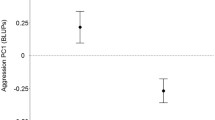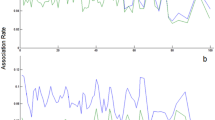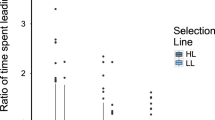Abstract
Although our understanding of how animal personality affects fitness is incomplete, one general hypothesis is that personality traits (e.g. boldness and aggressiveness) contribute to competitive ability. If so, then under resource limitation, personality differences will generate variation in life history traits crucial to fitness, like growth. Here, we test this idea using data from same-sex dyadic interaction trials of sheepshead swordtails (Xiphophorus birchmanni). In males, there was evidence of repeatable variation across a suite of agonistic contest behaviours, while repeatable opponent effects on focal behaviour were also detected. A single vector explains 80 % of the among-individual variance in multivariate phenotype and can be viewed as aggressiveness. We also find that aggressiveness predicts dominance—the repeatable tendency to win food in competition—and dominant individuals show faster post-trial weight gain (independently of initial size). In females, a dominance hierarchy predictive of weight gain was also found, but there was no evidence of variation in aggressiveness. While size often predicts contest outcome, our results show that individuals may sometimes grow larger because they are behaviourally dominant rather than vice versa. When resources are limited, personality traits such as aggression can influence growth, life history, and fitness through impacts on resource acquisition.



Similar content being viewed by others
References
Archard GA, Braithwaite VA (2011) Variation in aggressive behaviour in the poeciliid fish Brachyrhaphis episcopi: population and sex differences. Behav Process 86:52–57
Arnott G, Elwood RW (2009) Assessment of fighting ability in animal contests. Anim Behav 77:991–1004
Beaugrand JP, Goulet C (2000) Distinguishing kinds of prior dominance and subordination experiences in males of green swordtail fish (Xiphophorus helleri). Behav Process 50:131–142
Berghänel A, Ostner J, Schülke O (2011) Coalitions destabilize dyadic dominance relationships in male Barbary macaques (Macaca sylvanus). Behaviour 148:1256–1274
Biro PA, Stamps J (2008) Are animal personality traits linked to life-history productivity? Trends Ecol Evol 23:361–368
Chen T, Beekman M, Ward AJW (2011) The role of female dominance hierarchies in the mating behaviour of mosquitofish. Biol Lett 7:343–345
Colleter M, Brown C (2011) Personality traits predict hierarchy rank in male rainbowfish social groups. Anim Behav 81:1231–1237
Dall SR, Bell AM, Bolnick DI, Ratnieks FL (2012) An evolutionary ecology of individual differences. Ecol Lett 15:1189–1198
Dingemanse NJ, Dochtermann NA (2013) Quantifying individual variation in behaviour: mixed-effect modelling approaches. J Anim Ecol 82:39–54
Dingemanse NJ, Réale D (2005) Natural selection and animal personality. Behaviour 142:1165–1190
Dingemanse NJ, Van der Plas F, Wright J, Réale D, Schrama M, Roff DA, Van der Zee E, Barber I (2009) Individual experience and evolutionary history of predation affect expression of heritable variation in fish personality and morphology. Proc R Soc Lond B 276:1285–1293
Earley RL (2006) Xiphophorus: carving a niche towards a broader understanding of aggression and dominance. Zebrafish 3:283–293
Earley RL, Dugatkin LA (2002) Eavesdropping on visual cues in green swordtail (Xiphophorus helleri) fights: a case for networking. Proc R Soc Lond B 269:943–952
Fisher HS, Rosenthal GG (2006) Female swordtail fish use chemical cues to select well-fed mates. Anim Behav 72:721–725
Foran CM, Ryan MJ (1994) Female-female competition in a unisexual/bisexual complex of mollies. Copeia 1994:504–508
Francis RC (1988) On the relationship between aggression and social dominance. Ethology 78:223–237
Franck D, Ribowski A (1993) Dominance hierarchies of male green swordtails (Xiphophorus helleri) in nature. J Fish Biol 43:497–499
Franck D, Klamroth B, Taebel-Hellwig A, Schartl M (1998) Home ranges and satellite tactics of male green swordtails (Xiphophorus helleri) in nature. Behav Process 43:115–123
Huntingford FA, Turner AK (1987) Animal conflict. Chapman & Hall, London
Just W, Morris MR (2003) The Napoleon Complex: why smaller males pick fights. Evol Ecol 17:509–522
Lampert KP, Schmidt C, Fischer P, Volff J-N, Hoffmann C, Muck J, Lohse MJ, Ryan MJ, Schartl M (2010) Determination of onset of sexual maturation and mating behavior by melanocortin receptor 4 polymorphisms. Curr Biol 20:1729–1734
Magellan K, Kaiser H (2010) The function of aggression in the swordtail, Xiphophorus helleri: resource defence. J Ethol 28:239–244
Magurran AE, Seghers BH (1991) Variation in schooling and aggression amongst guppy (Poecilia reticulata) populations in Trinidad. Behaviour 118:214–234
Makowicz AM, Plath M, Schlupp I (2010) Using video playback to study the effect of an audience on male mating behavior in the Sailfin molly (Poecilia latipinna). Behav Process 85:36–41
Meffe GK, Snelson FF (1989) Ecology and evolution of livebearing fishes (Poeciliidae). Prentice Hall, Englewood Cliffs
Metcalfe NB, Taylor AC, Thorpe JE (1995) Metabolic rate, social status and life-history strategies in Atlantic salmon. Anim Behav 49:431–436
Moore AJ, Brodie ED, Wolf JB (1997) Interacting phenotypes and the evolutionary process. 1. Direct and indirect genetic effects of social interactions. Evolution 51:1352–1362
Morris MR, Batra P, Ryan MJ (1992) Male-male competition and access to females in the swordtail Xiphophorus nigrensis. Copeia 1992:980–986
Morris MR, Gass L, Source MJ (1995) Assessment and individual recognition of opponents in the pygmy swordtails Xiphophorus nigrensis and X. multilineatus. Behav Ecol Sociobiol 37:303–310
Mowles SL, Cotton PA, Briffa M (2012) Consistent crustaceans: the identification of stable behavioural syndromes in hermit crabs. Behav Ecol Sociobiol 66:1087–1094
Parker GA (1974) Assessment strategy and the evolution of fighting behaviour. J Theor Biol 47:223–243
Penke L, Denissen JJA, Miller GF (2007) The evolutionary genetics of personality. Eur J Personal 21:549–587
Prenter J, Taylor PW, Elwood RW (2008) Large body size for winning and large swords for winning quickly in swordtail males, Xiphophorus helleri. Anim Behav 75:1981–1987
Réale D, Reader SM, Sol D, McDougall PT, Dingemanse NJ (2007) Integrating animal temperament within ecology and evolution. Biol Rev 82:291–318
Rudin FS, Briffa M (2012) Is boldness a resource holding potential trait? Fighting prowess and changes in startle response in the sea anemone Actinia equina. Proc R Soc Lond B 279:1904–1910
Ryan MJ, Hews DK, Wagner WEJ (1990) Sexual selection on alleles that determine body size in the swordtail Xiphophorus nigrensis. Behav Ecol Sociobiol 26:231–237
Schuett W, Tregenza T, Dall SRX (2010) Sexual selection and animal personality. Biol Rev 85:217–246
Sih A, Bell A, Johnson JC (2004) Behavioral syndromes: an ecological and evolutionary overview. Trends Ecol Evol 19:372–378
Smith BR, Blumstein DT (2008) Fitness consequences of personality: a meta-analysis. Behav Ecol 19:448–455
Stamps J (2007) Growth-mortality tradeoffs and 'personality traits' in animals. Ecol Lett 10:355–363
van Oers K, Drent PJ, de Jong G, van Noordwijk MA (2004) Additive and nonadditive genetic variation in avian personality traits. Heredity 93:496–503
Visscher PM (2006) A note on the asymptotic distribution of likelihood ratio tests to test variance components. Twin Res Hum Genet 9:490–495
Wilson AJ (2013) Competition as a source of constraint on life history evolution in natural populations. Heredity. doi:10.1038/hdy.2013.7
Wilson AJ, Gelin G, Perron M, Réale D (2009) Indirect genetic effects and the evolution of aggression in a vertebrate system. Proc R Soc Lond B 276:533–541
Wilson AJ, de Boer M, Arnott G, Grimmer A (2011a) Integrating personality research and animal contest theory: aggressiveness in the green swordtail Xiphophorus helleri. PLoS One 6:e28024
Wilson AJ, Morrissey MB, Adams M, Walling CA, Guinness FE, Pemberton JM, Clutton-Brock TH (2011b) Genetics of social dominance in red deer, Cervus elaphus. J Evol Biol 24:772–783
Wong BBM, Rosenthal GG (2005) Shoal choice in swordtails when preferences conflict. Ethology 111:179–186
Acknowledgments
This work was funded by a BBSRC David Phillips Fellowship awarded to AJW. We thank the Mexican federal government for the permission to collect fish, and Holly Kindsvater, Olivia Ochoa, Gaston Jofre, and Palestina Guevara Fiore for their assistance with collection and transport. We also thank the technicians of the animal care facility at the University of Edinburgh for their assistance with husbandry.
Author information
Authors and Affiliations
Corresponding author
Additional information
Communicated by N. Dingemanse
Ethics standards
All work described here was subject to approval by local ethical review (University of Edinburgh Local Ethical Review Committee) and conducted under the auspices of the Home Office (UK) under the Animals (Scientific Procedures) Act 1986. Criteria were in place to terminate any behavioural trial immediately in the event of physical injury or overt distress to any animal. This was not deemed necessary on any occasion, and no fish received physical injury during the experiments conducted.
Electronic supplementary material
Below is the link to the electronic supplementary material.
ESM 1
(PDF 97 kb)
Rights and permissions
About this article
Cite this article
Wilson, A.J., Grimmer, A. & Rosenthal, G.G. Causes and consequences of contest outcome: aggressiveness, dominance and growth in the sheepshead swordtail, Xiphophorus birchmanni . Behav Ecol Sociobiol 67, 1151–1161 (2013). https://doi.org/10.1007/s00265-013-1540-7
Received:
Revised:
Accepted:
Published:
Issue Date:
DOI: https://doi.org/10.1007/s00265-013-1540-7




